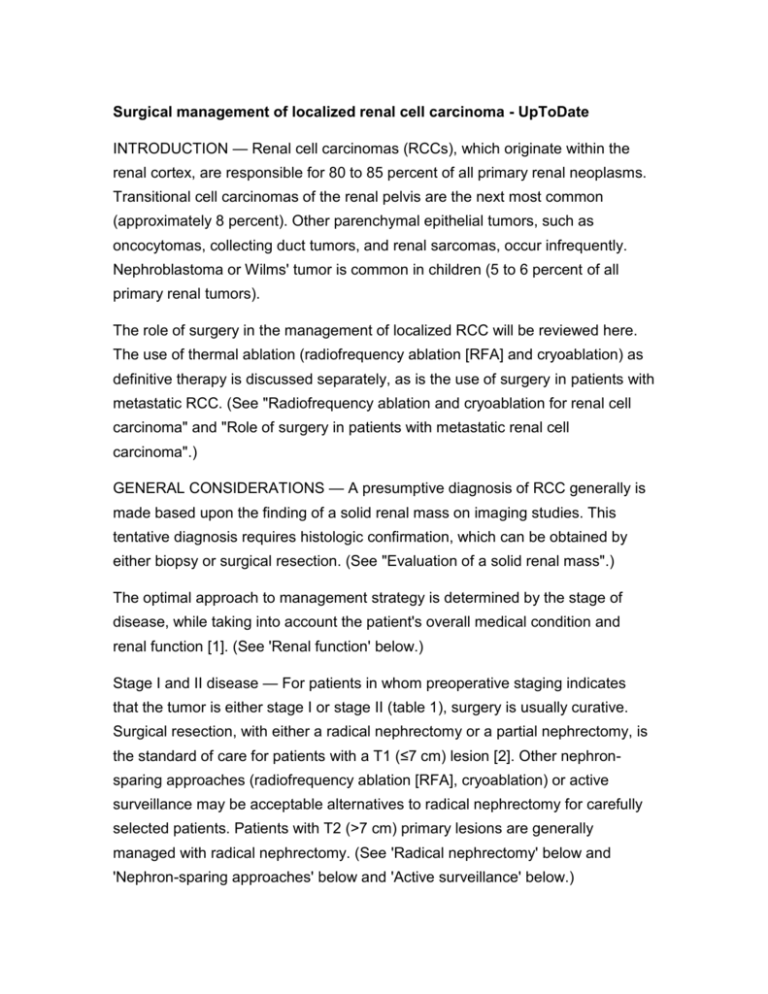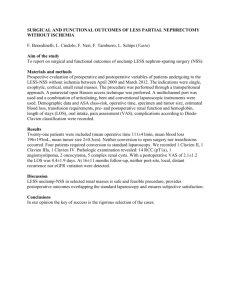
Surgical management of localized renal cell carcinoma - UpToDate
INTRODUCTION — Renal cell carcinomas (RCCs), which originate within the
renal cortex, are responsible for 80 to 85 percent of all primary renal neoplasms.
Transitional cell carcinomas of the renal pelvis are the next most common
(approximately 8 percent). Other parenchymal epithelial tumors, such as
oncocytomas, collecting duct tumors, and renal sarcomas, occur infrequently.
Nephroblastoma or Wilms' tumor is common in children (5 to 6 percent of all
primary renal tumors).
The role of surgery in the management of localized RCC will be reviewed here.
The use of thermal ablation (radiofrequency ablation [RFA] and cryoablation) as
definitive therapy is discussed separately, as is the use of surgery in patients with
metastatic RCC. (See "Radiofrequency ablation and cryoablation for renal cell
carcinoma" and "Role of surgery in patients with metastatic renal cell
carcinoma".)
GENERAL CONSIDERATIONS — A presumptive diagnosis of RCC generally is
made based upon the finding of a solid renal mass on imaging studies. This
tentative diagnosis requires histologic confirmation, which can be obtained by
either biopsy or surgical resection. (See "Evaluation of a solid renal mass".)
The optimal approach to management strategy is determined by the stage of
disease, while taking into account the patient's overall medical condition and
renal function [1]. (See 'Renal function' below.)
Stage I and II disease — For patients in whom preoperative staging indicates
that the tumor is either stage I or stage II (table 1), surgery is usually curative.
Surgical resection, with either a radical nephrectomy or a partial nephrectomy, is
the standard of care for patients with a T1 (≤7 cm) lesion [2]. Other nephronsparing approaches (radiofrequency ablation [RFA], cryoablation) or active
surveillance may be acceptable alternatives to radical nephrectomy for carefully
selected patients. Patients with T2 (>7 cm) primary lesions are generally
managed with radical nephrectomy. (See 'Radical nephrectomy' below and
'Nephron-sparing approaches' below and 'Active surveillance' below.)
Factors that are important in determining whether a partial or radical
nephrectomy is preferred include the location of the tumor within the kidney,
whether multiple tumors exist, and the presence of either a solitary kidney or a
concurrent disorder associated with multiple RCCs (eg, von Hippel-Lindau
disease). In addition, particular attention should be paid to the underlying renal
function and the risk of chronic kidney disease. (See 'Renal function' below.)
Stage III disease — Radical nephrectomy is the preferred approach for patients
with stage III disease (table 1). Stage III disease includes patients with tumor
invasion into the adrenal gland or perinephric tissues (but not extending beyond
Gerota's fascia), those with enlarged abdominal lymph nodes, and those with
invasion of the renal vein and/or inferior vena cava (IVC).
Specific surgical considerations for patients with stage III disease include:
Among those with radiologic evidence of abdominal lymph node
involvement, a standard radical nephrectomy should be considered, since many
nodes initially suspected of harboring tumor radiologically are enlarged only
because of reactive inflammation [1]. (See 'Lymph node dissection' below.)
Involvement of the renal vein and/or IVC does not preclude a successful
surgical resection. (See 'Cavoatrial tumor involvement' below.)
Stage IV disease — Patients with stage IV RCC are defined as those with large
tumors extending beyond Gerota's fascia, obvious evidence of extensive disease
in regional lymph nodes, and/or distant metastases (table 1).
Nephrectomy may be indicated for palliation of local symptoms or in advance of
systemic immunotherapy, or when tumor extends into an adjacent organ (T4)
without other evidence of metastatic spread [3]. Surgical resection of metastases
may also be indicated in selected situations. (See "Role of surgery in patients
with metastatic renal cell carcinoma".)
Renal function — Prior to surgery, the glomerular filtration rate should be
estimated from a stable serum creatinine concentration using the Modification in
Diet and Renal Disease (MDRD) equation (calculator 1). Patients with impaired
renal function may be candidates for partial nephrectomy or an alternative
nephron-sparing approach [4,5]. (See "Assessment of kidney function: Serum
creatinine; BUN; and GFR", section on 'Estimation equations' and 'Nephronsparing approaches' below.)
Partial versus radical nephrectomy — The impact of partial versus radical
nephrectomy on subsequent renal function was evaluated in a retrospective
cohort study of 662 patients with small (<4 cm) solitary cortical lesions, an
apparently healthy contralateral kidney, and a serum creatinine less than 1.4
mg/dL (124 micromol/L) [4]. Prior to surgery, 24 percent of patients had an
estimated GFR between 45 and 59 mL/min per 1.73 m2 and 2 percent had an
estimated GFR between 30 and 44 mL/min per 1.73 m2.
Three years after surgery, patients undergoing partial nephrectomy had a
significantly lower likelihood of having a glomerular filtration rate below 45
mL/min per 1.73 m2 than those undergoing radical nephrectomy (5 versus 36
percent).
Preservation of renal function may be associated with improved survival. This
was suggested in a retrospective single institution study of 1004 patients
managed with either partial or radical nephrectomy for localized primary renal cell
carcinoma between 4 and 7 cm [6]. In this nonrandomized study, the five-year
cancer-specific survival rate was at least equivalent for partial nephrectomy after
correcting for T stage and nuclear grade. However, loss of renal function with
radical nephrectomy was associated with a significantly increased risk of cardiac
death and a decrease in overall survival (five-year overall survival 78 versus 85
percent for patients treated with radical and partial nephrectomy, respectively).
Solitary kidney — In patients with a solitary kidney, ablative techniques may be
especially useful for preservation of renal function. This was illustrated in a
retrospective series of 89 patients with 98 tumors in a solitary kidney, in which
decline in glomerular filtration rate was significantly less in those treated with
radiofrequency ablation compared with those managed with open partial
nephrectomy (10 versus 25 percent at 12 months) [7]. A possible mechanism is
avoidance of cold ischemia during surgery.
RADICAL NEPHRECTOMY — Radical nephrectomy consists of ligation of the
renal artery and vein, and excision of the kidney, Gerota's fascia, and ipsilateral
adrenal gland. This became the procedure of choice in the 1960s when a study
reported a superior five-year survival rate compared with simple nephrectomy (66
versus 48 percent, respectively) [8]. As with other urologic malignancies,
hospitals and surgeons doing a higher volume of nephrectomies have lower
mortality rates than those with lower volumes [9].
Several surgical approaches are available for the satisfactory performance of
radical nephrectomy. The thoracoabdominal approach offers the ability to palpate
the ipsilateral lung cavity and mediastinum, and to resect a solitary pulmonary
metastasis [8,10,11]. An extrapleural supracostal incision or an anterior
transabdominal incision may also be performed. Independent of the surgical
approach, early ligation of the vascular pedicle is important to prevent tumor
dissemination at surgery.
Laparoscopic nephrectomy — Laparoscopic nephrectomy represents a
reasonable alternative to open radical nephrectomy for T1 and T2 RCCs <10 cm
[12-15]. Although technically demanding, the oncologic outcome appears to be
equivalent to open nephrectomy in series with long-term outcome. Seeding at the
operative sites has been described only rarely [16]. Intact specimen removal is
preferred to piecemeal removal [17].
Management of the adrenal gland — The need for prophylactic ipsilateral
adrenalectomy is controversial. Involvement of the ipsilateral adrenal gland is
uncommon (5 percent or less) [18-20]. Adrenal gland involvement is usually due
to direct extension from a large upper pole lesion; adrenal involvement in
association with extraadrenal metastases is also seen. Although some series
suggest that a negative staging CT scan effectively excludes adrenal
involvement by tumor [19], others report a false negative rate as high as 23
percent [20].
Adrenalectomy is typically reserved for patients with large (>4 cm) upper pole
lesions, non-organ confined tumor stage (T3 or greater), or solitary ipsilateral
adrenal metastases identified by preoperative imaging studies (table 1).
Lymph node dissection
No suspected nodal metastases — The use of routine extended
lymphadenectomy in conjunction with radical nephrectomy is controversial when
there is no preoperative evidence of lymph node involvement. The rationale for
this approach is that lymphadenectomy adds little morbidity, allows better
evaluation of the extent of disease, decreases local recurrence rates, and
potentially improves survival [21-27].
A randomized phase 3 trial conducted by the European Organization for
Research and Treatment of Cancer (EORTC 30881) randomly assigned 772
patients to radical nephrectomy alone or with lymph node dissection [28]. At a
median follow-up of over 12 years, there were no differences in overall survival or
deaths due to cancer in the two treatment arms.
However, only 4 percent of patients assigned to lymph node dissection had
positive nodes, probably due to earlier diagnosis and more effective preoperative
evaluation. As a result, the study included a large proportion of patients in whom
lymph node dissection may not have been indicated and was significantly
underpowered to demonstrate any benefit in those patients who would be most
likely to benefit from lymphadenectomy [29].
A lymph node dissection may remain important for patients who are at increased
risk of having lymph node involvement. We suggest performing a lymph node
dissection limited to the renal hilum for patients who are undergoing radical
nephrectomy in whom nodal metastases are not suspected.
Suspected nodal metastases — Extended lymphadenectomy is indicated when
nodal metastases are suspected on a preoperative CT scan and there is no
evidence of distant metastases. In such patients, extended lymphadenectomy
can be curative, and systemic treatment options are generally not curative for
regional nodal disease.
Cavoatrial tumor involvement — RCC is complicated by tumor thrombus
involving the inferior vena cava (IVC) or right atrium in 5 to 10 percent of cases
[30]. The extent of involvement is important for staging (table 1) and surgical
planning (figure 1). Preoperative magnetic resonance imaging (MRI) is generally
the best test to determine the presence and/or extent of cavoatrial thrombus
[31,32].
Extension of tumor into the IVC does not necessarily preclude a favorable longterm outcome. Radical nephrectomy with thrombectomy can provide immediate
palliation of symptoms and five-year survival rates up to 72 percent, if there are
no nodal or distant metastases and tumor does not invade perinephric fat [33,34].
Patients with mobile tumor thrombus rather than tumor directly invading the IVC
wall may have a better outcome after extraction of the thrombus (five year
survival 69 versus 26 percent in one series) [35].
Simple thrombectomy may suffice for patients with thrombus extending below the
major hepatic veins. For thrombi located above the major hepatic veins,
cardiopulmonary bypass and hypothermic circulatory arrest may be required for
complete resection [33,36,37]. Because of its greater morbidity, this approach
should generally be reserved for patients without evidence of distant or nodal
metastases. Five-year survival is dismal in patients with distant metastases, and
thrombectomy should only be considered in these cases as part of a trial
evaluating systemic therapy [38]. Limited evidence suggests that aggressive
therapy (radical nephrectomy, thrombectomy, postoperative immunotherapy)
may produce long-term survival in some patients with advanced disease [34,39].
A minimally invasive technique for thrombus removal above the hepatic veins
has been described [40]. This may reduce perioperative morbidity and mortality,
thereby expanding the utility of nephrectomy in this patient population [40].
Two potentially fatal complications of cavoatrial thrombus are thrombus migration
and embolization [41]. Intraoperative transesophageal echocardiography may be
useful to detect tumor thrombus migration [30]. Preoperative embolization is rare
because the tumor thrombus tends to have a "capsule" and does not readily
break off small pieces. IVC filters are generally avoided as they need to be
placed above the renal veins and if they become blocked, can impair function of
the remaining kidney. Heparin has been used in cases where embolization has
occurred preoperatively. (See "Pulmonary tumor embolism".)
Preoperative angioinfarction — Angioinfarction has been used to reduce
vascularity and lower the risk of hemorrhage during nephrectomy with large,
marginally resectable tumors [42]. The technique has also been used to control
symptoms (bleeding, pain) in patients with unresectable or symptomatic
metastatic disease [43].
Several techniques have been developed for embolizing the renal artery [44].
Most patients experience pain, fever, and nausea, which may last for several
days following the procedure.
Spontaneous regression of metastases is rare following sequential
angioinfarction and nephrectomy; in addition, no survival benefit has been
observed compared with patients undergoing nephrectomy alone [45,46].
Adjuvant therapy
Immunotherapy — The ability of immunotherapy to induce responses in some
patients with advanced RCCs has led to the evaluation of various
immunotherapeutic strategies as an adjuvant following complete surgical
resection. However, multiple randomized trials have not demonstrated a survival
benefit in this setting with any form of immunotherapy. (See "Immunotherapy of
renal cell carcinoma", section on 'Adjuvant immunotherapy'.)
Molecularly targeted therapy — Progress in the treatment of advanced RCC
using molecularly targeted agents has led to the initiation of clinical trials to test
these approaches for patients at high risk following surgery. Although preliminary
studies have demonstrated the feasibility of neoadjuvant treatment [47,48], the
use of such agents is not indicated outside the context of a clinical trial. (See
"Molecularly targeted therapy for advanced renal cell carcinoma".)
NEPHRON-SPARING APPROACHES — Patients with RCCs, particularly those
in whom the removal of large amounts of renal tissue would result in the
significant loss of renal function, should be managed with nephron-sparing
approaches when possible. Options for appropriately selected patients include
partial nephrectomy, thermal ablation (radiofrequency ablation [RFA] and
cryotherapy), and active surveillance.
Partial nephrectomy
Indications and outcomes — There are no randomized trials that compare partial
nephrectomy with radical nephrectomy.
Observational data indicate that the oncologic outcomes are similar to radical
nephrectomy, at least for patients with T1 tumors (table 1) [49-53]. This was
illustrated by the composite experience in 1454 patients from seven centers [49].
With a mean follow-up of over five years, there were no significant differences in
local or distant recurrence rates with T1N0M0 tumors treated with either partial (n
= 379) or radical (n = 1075) nephrectomy. Approximately 85 percent of the partial
nephrectomies were performed for tumors ≤ 4 cm (ie, T1a), but results in this
[49] and other series [51-53] support the use of partial nephrectomy in patients
with T1b tumors.
In contrast, the oncologic outcomes in patients with T2 or greater disease are
uncertain, with some series reporting inferior outcomes [54,55], while one center
has observed comparable outcomes in carefully selected patients [56].
Thus, partial nephrectomy has become the standard of care for patients with T1a
(≤4 cm) primary tumors, and is an appropriate alternative for those with T1b (>4
to <7 cm) tumors when preserving renal function is an important consideration
[2]. Factors that might lead to a particular consideration of partial rather than
radical nephrectomy include the presence of bilateral tumors, a tumor in a
solitary kidney, or the presence of compromised renal function [49,57].
If nephron-sparing surgery is attempted, intraoperative findings may preclude the
completion of such surgery. Most urologists, for example, recommend converting
the surgery to radical nephrectomy in cases with renal vein invasion or
sarcomatoid histology on frozen section.
Up to 15 percent of patients with papillary tumors and 8 percent of those with
other histologic subtypes have multicentric tumors [58], which would not be
detected with a partial nephrectomy and could lead to recurrent disease.
However, reported rates of local recurrence are low (0 to 10 percent) in
appropriately selected patients [49,54,57,59-64].
Complications of nephron-sparing surgery are similar to nephrectomy and
include urinary fistulae, acute renal failure, the need for temporary or permanent
dialysis, and bleeding (7, 6, 5, and 2 percent of cases, respectively, in one
series) [59].
Positive surgical margins — The clinical significance of positive surgical margins
is unclear, and positive margins do not necessarily imply an ominous prognosis
[65,66]. Every effort should be made to ensure negative margins at the time of
surgery, but an incidental finding on the final pathology specimen can be
managed with careful surveillance [66].
The result of this conservative approach to a positive surgical margin is illustrated
by a series of 1390 patients who underwent partial nephrectomy at one of two
high volume institutions [66]. If margins were positive at frozen section,
reresection or completion nephrectomy was undertaken. Overall, 77 patients (6
percent) had margins that were positive only on the final pathology examination
and not by frozen section. These patients were managed with surveillance only.
In this series, there was no difference in the five- and ten-year probabilities of
local recurrence-free survival compared to those patients with negative margins
(98 versus 97 and 91 versus 93 percent, respectively). There also was no
difference in the incidence of distant metastases.
Adrenalectomy — In most patients undergoing partial nephrectomy, concomitant
adrenalectomy should be restricted to those with a suspicious lesion identified on
preoperative imaging or to those in whom adrenal invasion is suspected based
upon intraoperative findings.
The limited role of adrenalectomy in conjunction with partial nephrectomy was
illustrated by a series of 2065 patients undergoing partial nephrectomy at a single
institution, in which concomitant adrenalectomy was performed in 48 cases (2
percent) [67]. Of these, one patient had RCC directly invading the adrenal, two
patients had adrenal metastases, and three had other adrenal tumors. Benign
lesions were found in 42 cases (87 percent).
Small multiple and/or bilateral tumors — Although bilateral tumors are more
common with inherited conditions (eg, von Hippel-Lindau disease, familial
papillary RCC), between 1 and 4 percent of patients with apparently sporadic
tumors also have bilateral RCCs [68].
For patients who have multiple and/or bilateral tumors, some clinicians advocate
waiting until the largest lesion is greater than 3 cm before performing a partial
nephrectomy in order to preserve renal parenchyma [69]. Allowing such tumors
to grow beyond 3 cm before resection may be detrimental. This size criterion was
derived from studies in patients with von Hippel-Lindau disease, in whom
preservation of renal parenchyma is critically important because of the high
likelihood of additional subsequent renal lesions. (See "Clinical features,
diagnosis, and management of von Hippel-Lindau disease", section on 'Renal
cell carcinomas'.)
During nephron-sparing surgery, the kidney should be carefully examined to
exclude a second malignancy. The importance of this approach was illustrated by
a series of 112 patients with sporadic renal masses that included 25 with
presumed simple cysts identified preoperatively by imaging [70]. Overall, a
second lesion was identified and resected in 37 cases. Eight of the 37 second
lesions (22 percent) were malignant, including 4 of the 25 (16 percent) with
presumed benign cysts. The authors concluded that a partial nephrectomy was
still appropriate therapy for these patients, based upon the small size of the
additional malignant lesions and the favorable prognosis.
Simple enucleation rather than partial nephrectomy has been used as a
treatment for T1a RCC (table 1). This approach has been reported to yield
comparable results in patients with small tumors, but experience is more limited
than with other forms of partial nephrectomy [71]. Although enucleation is
reasonable for selected lesions in some patients with von Hippel-Lindau disease,
partial nephrectomy with a rim of normal renal parenchyma is preferable. In one
series, more than 50 percent of patients with renal cell carcinoma who underwent
enucleation ex vivo after radical nephrectomy still had residual carcinoma
adjacent to the pseudocapsule [72].
Continued surveillance is required after partial nephrectomy, since patients are at
risk for recurrence of the original lesion as well as additional tumors. However,
the risk of developing metastatic disease appears to be relatively low as long as
the patient is followed carefully. (See "Surveillance for metastatic disease after
nephrectomy for renal cell carcinoma".)
Bench dissection — The role of techniques such as "bench dissection" in
patients with larger or centrally located tumors is unclear [57,73]. One study
found that only 6 of 16 patients who underwent initially successful "bench
surgery" and renal autotransplantation were eventually free of both malignancy
and the need for dialysis [73]. In addition, in patients with tumors invading the
adrenal gland or perinephric tissue, partial nephrectomy should be restricted to
clinical studies since the incidence of multifocality may be as high as 50 percent.
Laparoscopy — Laparoscopic techniques have been used to perform partial
nephrectomy for both peripheral and central lesions and in patients with a solitary
kidney [74-76]. Seven-year follow-up data suggest that this approach gives
results that are comparable to open partial nephrectomy [74,75]. This procedure
is technically difficult and should be restricted to physicians with extensive
experience using this approach. In patients with a solitary kidney, an open
approach may be preferred, because laparoscopic surgery has been associated
with a longer warm ischemia time and a higher incidence of complications [77].
Superselective embolization of the tumor may reduce the risk of bleeding, thus
facilitating a laparoscopic approach [78,79]. This approach is experimental.
Positive margins have been identified in 2 to 3 percent of patients on the final
pathology following laparoscopic partial nephrectomy [65,80]. The significance of
this finding and whether or not additional treatment is required remains uncertain
[65].
Thermal ablation techniques — Thermal ablation techniques, including
radiofrequency ablation (RFA) and cryoablation, permit percutaneous tumor
treatment without open surgical intervention. Both approaches are limited by the
absence of pathologic confirmation of the diagnosis or the diagnostic accuracy
possible with a small sample from a needle biopsy. A nondiagnostic biopsy at the
time of ablation does not exclude the possibility of RCC [81], and careful followup is indicated [82].
There are no randomized trials comparing these approaches with surgery. RFA
cryoablation are discussed separately. (See "Radiofrequency ablation and
cryoablation for renal cell carcinoma".)
Active surveillance — The development and widespread use of improved
imaging modalities (MRI, CT) has led to an increased detection of smaller
lesions. The natural history of these smaller solid renal masses can be quite
variable. (See "Evaluation of a solid renal mass", section on 'Natural history'.)
For individuals with small lesions and significant comorbidity or a short life
expectancy, active surveillance may be an appropriate alternative to immediate
treatment [2]. The potential utility of active surveillance was illustrated by a
single-institution retrospective series of 212 patients [83]. The median patient age
was 71 years, and the median Charlson comorbidity index was 3 (table 2). The
median tumor size and growth rate were 2.8 cm and 0.34 cm/year. At a median
follow-up of three years, active surveillance had been terminated in 15 patients (7
percent), four of whom developed metastases and 11 required treatment.
POSTTREATMENT SURVEILLANCE — The optimal surveillance strategy after
potentially curative treatment for RCC has not been well studied. Follow-up
should be based upon the most likely sites and timing of metastases. (See
"Surveillance for metastatic disease after nephrectomy for renal cell carcinoma".)
INFORMATION FOR PATIENTS — Educational materials on this topic are
available for patients. (See "Patient information: Renal cell carcinoma (kidney
cancer)".) We encourage you to print or e-mail this topic review, or to refer
patients to our public web site, www.uptodate.com/patients, which includes this
and other topics.
SUMMARY AND RECOMMENDATIONS — Surgical resection remains the
preferred approach for patients with stage I, II, or III renal cell carcinoma (RCC)
(table 1). The choice of radical or partial nephrectomy is based upon multiple
factors, including the stage and location of the tumor, whether multiple tumors
exist, the presence of either a solitary kidney or a concurrent disorder associated
with multiple RCCs (eg, von Hippel-Lindau disease), and underlying renal
function [2]. Both open and laparoscopic approaches can be used for either
radical or partial nephrectomy. (See 'General considerations' above.)
For patients with stage I, II, or III RCC without comorbidity precluding
resection, we recommend definitive therapy rather than active surveillance or a
lesser approach (Grade 1A). Surgical resection is the standard approach for
definitive therapy. This approach has been shown to offer a high-probability of
long-term disease-free survival. There are insufficient long-term follow-up data
from ablative procedures to establish the equivalence of these approaches. (See
'Stage I and II disease' above and 'Stage III disease' above.)
- For patients with a T1a (≤4 cm) primary tumor, we suggest partial
nephrectomy rather than radical nephrectomy (Grade 2C). This approach
maximizes the preservation of renal parenchyma and thus decreases the risk of
chronic kidney disease. Radical nephrectomy is an appropriate alternative when
partial nephrectomy is not technically feasible. (See 'Stage I and II
disease' above and 'Partial nephrectomy' above.)
- For patients with a T1b (>4 and <7 cm) lesion, we suggest radical
nephrectomy rather than partial nephrectomy (Grade 2C). Partial nephrectomy
may be preferred when there is an increased risk of renal insufficiency. (See
'Stage I and II disease' above and 'Radical nephrectomy' above.)
- For patients with large tumors and when there is evidence of invasion
into the adrenal, renal vein, or perinephric fat, radical nephrectomy has been the
most widely used approach and remains the preferred procedure. Involvement of
the inferior vena cava with tumor is not a contraindication to radical nephrectomy.
(See 'Radical nephrectomy' above.)
- For patients undergoing radical nephrectomy but without preoperative
evidence of lymph node involvement, we suggest limiting the surgery to resection
of lymph nodes at the renal hilum (Grade 2C). (See 'No suspected nodal
metastases' above.)
- For patients with suspected involvement of abdominal lymph node
involvement, we recommend a standard radical nephrectomy with retroperitoneal
lymph node dissection rather than radical nephrectomy alone (Grade 1B). Many
patients with suspected lymph node involvement may have only inflammation
present in these nodes. Furthermore, lymph node dissection is curative in a
significant number of these patients. (See 'Suspected nodal metastases' above.)
For elderly patients and those with significant comorbidities that increase
the risks of surgery, we suggest surgical resection rather than cryoablation or
radiofrequency ablation (Grade 2C).
- Cryotherapy and radiofrequency ablation are appropriate alternatives,
depending upon the assessment of the overall patient's condition. However, the
long-term risk of local recurrence has not been fully defined. (See 'General
considerations' above and "Radiofrequency ablation and cryoablation for renal
cell carcinoma".)
- When the individual has a markedly decreased life expectancy or a very
high risk of complications with active intervention, active surveillance may be an
option for those with a small lesion. (See 'Active surveillance' above and
"Evaluation of a solid renal mass", section on 'Natural history'.)
Use of UpToDate is subject to the Subscription and License Agreement.
REFERENCES
1.
2.
3.
4.
5.
6.
7.
8.
Vogelzang, NJ, Stadler, WM. Kidney cancer. Lancet 1998; 352:1691.
Campbell, SC, Novick, AC, Belldegrun, A, et al. Guideline for
management of the clinical T1 renal mass. J Urol 2009; 182:1271.
Margulis, V, Sanchez-Ortiz, RF, Tamboli, P, et al. Renal cell carcinoma
clinically involving adjacent organs: experience with aggressive surgical
management. Cancer 2007; 109:2025.
Huang, WC, Levey, AS, Serio, AM, et al. Chronic kidney disease after
nephrectomy in patients with renal cortical tumours: a retrospective cohort study.
Lancet Oncol 2006; 7:735.
Lucas, SM, Stern, JM, Adibi, M, et al. Renal function outcomes in patients
treated for renal masses smaller than 4 cm by ablative and extirpative
techniques. J Urol 2008; 179:75.
Weight, CJ, Larson, BT, Fergany, AF, et al. Nephrectomy Induced Chronic
Renal Insufficiency is Associated With Increased Risk of Cardiovascular Death
and Death From Any Cause in Patients With Localized cT1b Renal Masses. J
Urol 2010; 183:1317.
Raman, JD, Raj, GV, Lucas, SM, et al. Renal functional outcomes for
tumours in a solitary kidney managed by ablative or extirpative techniques. BJU
Int 2010; 105:496.
Robson, CJ. Radical nephrectomy for renal cell carcinoma. J Urol 1963;
89:37.
9.
Mitchell, RE, Lee, BT, Cookson, MS, et al. Radical nephrectomy surgical
outcomes in the University HealthSystem Consortium Data Base: impact of
Hospital Case Volume, Hospital Size, and Geographic Location on 40,000
Patients. Cancer 2009; 115:2447.
10.
Waters, WB, Richie, JP. Aggressive surgical approach to renal cell
carcinoma: Review of 130 cases. J Urol 1979; 122:306.
11.
Chute, R, Soutter, L, Kerr, WS Jr. The value of the thoracoabdominal
incision in the removal of kidney tumors. N Engl J Med 1949; 241:951.
12.
Gong, EM, Lyon, MB, Orvieto, MA, et al. Laparoscopic radical
nephrectomy: comparison of clinical Stage T1 and T2 renal tumors. Urology
2006; 68:1183.
13.
Burgess, NA, Koo, BC, Calvert, RC, et al. Randomized trial of
laparoscopic v open nephrectomy. J Endourol 2007; 21:610.
14.
Colombo, JR Jr, Haber, GP, Jelovsek, JE, et al. Seven years after
laparoscopic radical nephrectomy: oncologic and renal functional outcomes.
Urology 2008; 71:1149.
15.
Berger, A, Brandina, R, Atalla, MA, et al. Laparoscopic radical
nephrectomy for renal cell carcinoma: oncological outcomes at 10 years or more.
J Urol 2009; 182:2172.
16.
Tsivian, A, Sidi, AA. Port site metastases in urological laparoscopic
surgery. J Urol 2003; 169:1213.
17.
Cohen, DD, Matin, SF, Steinberg, JR, et al. Evaluation of the intact
specimen after laparoscopic radical nephrectomy for clinically localized renal cell
carcinoma identifies a subset of patients at increased risk for recurrence. J Urol
2005; 173:1487.
18.
O'Malley, RL, Godoy, G, Kanofsky, JA, Taneja, SS. The necessity of
adrenalectomy at the time of radical nephrectomy: a systematic review. J Urol
2009; 181:2009.
19.
Gill, IS, McLennan, BL, Kerbl, K, et al. Adrenal involvement from renal cell
carcinoma: Predictive value of computerized tomography. J Urol 1994; 152:1082.
20.
Siemer, S, Lehmann, J, Kamradt, J, et al. Adrenal metastases in 1635
patients with renal cell carcinoma: outcome and indication for adrenalectomy. J
Urol 2004; 171:2155.
21.
Robson, CJ, Churchill, BM, Anderson, W. The results of radical
nephrectomy for renal cell carcinoma. J Urol 1969; 101:297.
22.
Phillips, E, Messing, EM. Role of lymphadenectomy in the treatment of
renal cell carcinoma. Urology 1993; 41:9.
23.
Herrlinger, A, Schrott, KM, Schott, G, Sigel, A. What are the benefits of
extended dissection of the regional renal lymph nodes in the therapy of renal cell
carcinoma?. J Urol 1991; 146:1224.
24.
Giuliani, L, Giberti, C, Martorana, G, Rovida, S. Radical extensive surgery
for renal cell carcinoma: long-term results and prognostic factors. J Urol 1990;
143:468.
25.
Blom, JH, van Poppel, H, Marechal, JM, et al. Radical nephrectomy with
and without lymph node dissection: preliminary results of the EORTC
randomized phase III protocol 30881. EORTC Genitourinary Group. Eur Urol
1999; 36:570.
26.
Terrone, C, Guercio, S, De Luca, S, et al. The number of lymph nodes
examined and staging accuracy in renal cell carcinoma. BJU Int 2003; 91:37.
27.
Canfield, SE, Kamat, AM, Sanchez-Ortiz, RF, et al. Renal Cell Carcinoma
With Nodal Metastases in the Absence of Distant Metastatic Disease (Clinical
Stage TxN1-2M0): The Impact of Aggressive Surgical Resection on Patient
Outcome. J Urol 2006; 175:864.
28.
Blom, JH, van Poppel, H, Marechal, JM, et al. Radical nephrectomy with
and without lymph-node dissection: final results of European Organization for
Research and Treatment of Cancer (EORTC) randomized phase 3 trial 30881.
Eur Urol 2009; 55:28.
29.
Studer, UE, Birkhauser, FD. Lymphadenectomy combined with radical
nephrectomy: To do or not to do?. Eur Urol 2009; 55:35.
30.
Sigman, DB, Hasnain, JU, Del Pizzo, JJ, Sklar, GN. Real-time
transesophageal echocardiography for intraoperative surveillance of patients with
renal cell carcinoma and vena caval extension undergoing radical nephrectomy.
J Urol 1999; 161:36.
31.
Aslam Sohaib, SA, Teh, J, Nargund, VH, et al. Assessment of tumor
invasion of the vena caval wall in renal cell carcinoma cases by magnetic
resonance imaging. J Urol 2002; 167:1271.
32.
Goldfarb, DA, Novick, AC, Lorig, R, et al. Magnetic resonance imaging for
assessment of vena caval tumor thrombi: a comparative study with
venacavography and computerized tomography scanning. J Urol 1990;
144:1100.
33.
Welz, A, Schmeller, N, Schmitz, C, et al. Resection of hypernephromas
with vena caval or right atrial tumor extension using extracorporeal circulation
and deep hypothermic circulatory arrest: a multidisciplinary approach. Eur J
Cardiothorac Surg 1997; 12:127.
34.
Zisman, A, Wieder, JA, Pantuck, AJ, et al. Renal cell carcinoma with
tumor thrombus extension: biology, role of nephrectomy and response to
immunotherapy. J Urol 2003; 169:909.
35.
Hatcher, PA, Anderson, EE, Paulson, DF, et al. Surgical management and
prognosis of renal cell carcinoma invading the vena cava. J Urol 1991; 145:20.
36.
Chiappini, B, Savini, C, Marinelli, G, et al. Cavoatrial tumor thrombus:
Single-stage surgical approach with profound hypothermia and circulatory arrest,
including a review of the literature. J Thorac Cardiovasc Surg 2002; 124:684.
37.
Tsuji, Y, Goto, A, Hara, I, et al. Renal cell carcinoma with extension of
tumor thrombus into the vena cava: surgical strategy and prognosis. J Vasc Surg
2001; 33:789.
38.
Libertino, JA, Swierzewski, DJ, Swierzewski, MJ. Renal cell carcinoma
with extension into the vena cava. In: Reconstructive Urologic Surgery, 3rd ed,
Libertino, JA (Ed), Mosby, St. Louis 1998. p.47.
39.
Naitoh, J, Kaplan, A, Dorey, F, et al. Metastatic renal cell carcinoma with
concurrent inferior vena caval invasion: Long-term survival after combination
therapy with radical nephrectomy, vena caval thrombectomy and postoperative
immunotherapy. J Urol 1999; 162:46.
40.
Fitzgerald, JM, Tripathy, U, Svensson, LG, Libertino, JA. Radical
nephrectomy with vena caval thrombectomy using a minimal access approach
for cardiopulmonary bypass. J Urol 1998; 159:1292.
41.
Shuch, B, Larochelle, JC, Onyia, T, et al. Intraoperative thrombus
embolization during nephrectomy and tumor thrombectomy: critical analysis of
the University of California-Los Angeles experience. J Urol 2009; 181:492.
42.
DeKernion, JB. Treatment of advanced renal cell carcinoma - traditional
methods and innovative approaches. J Urol 1983; 130:2.
43.
Swanson, DA, Wallace, S, Johnson, DE. The role of embolization and
nephrectomy in the treatment of metastatic renal carcinoma. Urol Clin North Am
1980; 7:719.
44.
Linehan, WM, Shipley, WU, Parkinson, DR. Cancer of the Kidney and
Ureter. In: Cancer: Principles & Practice Oncology, 4th ed, DeVita, VT Jr,
Hellman, S, Rosenberg, SA (Eds), Lippincott, Philadelphia 1993. p.1023.
45.
Flanigan, RC. The failure of infarction and/or nephrectomy in stage IV
renal cell cancer to influence survival or metastatic regression. Urol Clin North
Am 1987; 14:757.
46.
Swanson, DA, Johnson, DE, von Eschenbach, AC, et al. Angioinfarction
plus nephrectomy for metastatic renal cell carcinoma. An update. J Urol 1983;
130:449.
47.
Thomas, AA, Rini, BI, Lane, BR, et al. Response of the primary tumor to
neoadjuvant sunitinib in patients with advanced renal cell carcinoma. J Urol
2009; 181:518.
48.
Thomas, AA, Rini, BI, Stephenson, AJ, et al. Surgical resection of renal
cell carcinoma after targeted therapy. J Urol 2009; 182:881.
49.
Patard, JJ, Shvarts, O, Lam, JS, et al. Safety and efficacy of partial
nephrectomy for all T1 tumors based on an international multicenter experience.
J Urol 2004; 171:2181.
50.
Pahernik, S, Roos, F, Hampel, C, et al. Nephron sparing surgery for renal
cell carcinoma with normal contralateral kidney: 25 years of experience. J Urol
2006; 175:2027.
51.
Crepel, M, Jeldres, C, Perrotte, P, et al. Nephron-sparing Surgery Is
Equally Effective to Radical Nephrectomy for T1BN0M0 Renal Cell Carcinoma: A
Population-based Assessment. Urology 2010; 75:271.
52.
Pahernik, S, Roos, F, Rohrig, B, et al. Elective nephron sparing surgery
for renal cell carcinoma larger than 4 cm. J Urol 2008; 179:71.
53.
Thompson, RH, Siddiqui, S, Lohse, CM, et al. Partial versus radical
nephrectomy for 4 to 7 cm renal cortical tumors. J Urol 2009; 182:2601.
54.
Belldegrun, A, Tsui, K-H, deKernion, JB, Smith RB. Efficacy of nephronsparing surgery for renal cell carcinoma: Analysis based on the new 1997 TumorNode-Metastasis staging system. J Clin Oncol 1999; 17:2868.
55.
Jeldres, C, Patard, JJ, Capitanio, U, et al. Partial versus radical
nephrectomy in patients with adverse clinical or pathologic characteristics.
Urology 2009; 73:1300.
56.
Breau, RH, Crispen, PL, Jimenez, RE, et al. Outcome of stage T2 or
greater renal cell cancer treated with partial nephrectomy. J Urol 2010; 183:903.
57.
Moll, V, Becht, E, Ziegler, M. Kidney preserving surgery in renal cell
tumors: Indications, techniques and results in 152 patients. J Urol 1993; 150:319.
58.
McKiernan, J, Yossepowitch, O, Kattan, MW, et al. Partial nephrectomy
for renal cortical tumors: pathologic findings and impact on outcome. Urology
2002; 60:1003.
59.
Uzzo, RG, Novick, AC. Nephron sparing surgery for renal tumors:
indications, techniques and outcomes. J Urol 2001; 166:6.
60.
Morgan, WR, Zincke, H. Progression and survival after renal-conserving
surgery for renal cell carcinoma: Experience in 104 patients and extended followup. J Urol 1990; 144:852.
61.
Steinbach, F, Stockle, M, Muller, SC, et al. Conservative surgery of renal
cell tumors in 140 patients: 21 years of experience. J Urol 1992; 148:24.
62.
Licht, MR, Novick, AC, Goormastic, M. Nephron sparing surgery in
incidental versus suspected renal cell carcinoma. J Urol 1994; 152:39.
63.
Marberger, M, Pugh, RCB, Auvert, J, et al. Conservation surgery of renal
carcinoma: The EIRSS experience. Br J Urol 1981; 53:528.
64.
Herr, HW. Partial nephrectomy for unilateral renal carcinoma and a normal
contralateral kidney: 10-year followup. J Urol 1999; 161:33.
65.
Permpongkosol, S, Colombo, JR Jr, Gill, IS, Kavoussi, LR. Positive
surgical parenchymal margin after laparoscopic partial nephrectomy for renal cell
carcinoma: oncological outcomes. J Urol 2006; 176:2401.
66.
Yossepowitch, O, Thompson, RH, Leibovich, BC, et al. Positive surgical
margins at partial nephrectomy: predictors and oncological outcomes. J Urol
2008; 179:2158.
67.
Lane, BR, Tiong, HY, Campbell, SC, et al. Management of the adrenal
gland during partial nephrectomy. J Urol 2009; 181:2430.
68.
Patel, MI, Simmons, R, Kattan, MW, et al. Long-term follow-up of bilateral
sporadic renal tumors. Urology 2003; 61:921.
69.
Bazeed, MA, Scharfe, T, Becht, E, et al. Conservative surgery of renal cell
carcinoma. Eur Urol 1986; 12:238.
70.
Raz, O, Mendlovic, S, Leibovici, D, et al. The prevalence of malignancy in
satellite renal lesions and its surgical implication during nephron sparing surgery.
J Urol 2007; 178:1892.
71.
Carini, M, Minervini, A, Masieri, L, et al. Simple enucleation for the
treatment of PT1a renal cell carcinoma: our 20-year experience. Eur Urol 2006;
50:1263.
72.
Marshall, FF, Taxy, JB, Fishman, EK, Chang, R. The feasibility of surgical
enucleation for renal cell carcinoma. J Urol 1986; 135:231.
73.
Stormont, TJ, Bilhartz, DL, Zincke, H. Pitfalls of "bench surgery' and
autotransplantation for renal cell carcinoma. Mayo Clin Proc 1992; 67:621.
74.
Lane, BR, Gill, IS. 7-Year oncological outcomes after laparoscopic and
open partial nephrectomy. J Urol 2010; 183:473.
75.
Ono, Y, Hattori, R, Gotoh, M, et al. Laparoscopic radical nephrectomy for
renal cell carcinoma: the standard of care already?. Curr Opin Urol 2005; 15:75.
76.
Gill, IS, Kavoussi, LR, Lane, BR, et al. Comparison of 1,800 laparoscopic
and open partial nephrectomies for single renal tumors. J Urol 2007; 178:41.
77.
Lane, BR, Novick, AC, Babineau, D, et al. Comparison of laparoscopic
and open partial nephrectomy for tumor in a solitary kidney. J Urol 2008;
179:847.
78.
Gallucci, M, Guaglianone, S, Carpanese, L, et al. Superselective
embolization as first step of laparoscopic partial nephrectomy. Urology 2007;
69:642.
79.
Simone, G, Papalia, R, Guaglianone, S, et al. Preoperative superselective
transarterial embolization in laparoscopic partial nephrectomy: technique,
oncologic, and functional outcomes. J Endourol 2009; 23:1473.
80.
Breda, A, Stepanian, SV, Liao, J, et al. Positive margins in laparoscopic
partial nephrectomy in 855 cases: a multi-institutional survey from the United
States and Europe. J Urol 2007; 178:47.
81.
Permpongkosol, S, Link, RE, Solomon, SB, Kavoussi, LR. Results of
computerized tomography guided percutaneous ablation of renal masses with
nondiagnostic pre-ablation pathological findings. J Urol 2006; 176:463.
82.
Matin, SF, Ahrar, K, Cadeddu, JA, et al. Residual and recurrent disease
following renal energy ablative therapy: a multi-institutional study. J Urol 2006;
176:1973.
83.
Rosales, JC, Haramis, G, Moreno, J, et al. Active surveillance for renal
cortical neoplasms. J Urol 2010; 183:1698.
© 2010 UpToDate, Inc. All rights reserved.










